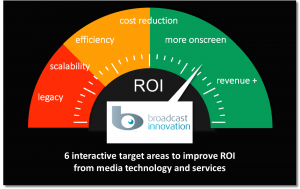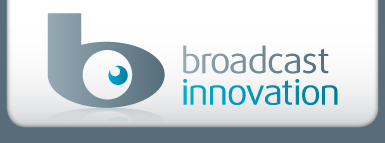ROI Part II. No Pain. No gain. In the green…
Last month I suggested that the return on investment (ROI) from media technology investment falls short if the benefit side of the equation is not fully explored and captured. And how broadcasters are increasingly asking Broadcast Innovation to help them focus on the potential upsides whilst astutely balancing their legacy with potential new technology and services, improved workflow possibilities and on-screen improvements.

To access new audiences and revenue requires an integrated approach that is lead by business requirements. In part 2 we’ll drive into the green on our dial.
Cost Reduction and Increased Output
You might think immediately of ideas to increase efficiency or improve staff productivity. But efficiency by itself isn’t worth much. To improve ROI it is real cost reduction and increased output that matters. And quality.
Production and media operations are usually targeted to suggest and then achieve these savings; always a contentious area. Today’s processes are often perceived as inefficient by default. Legacy processes and segregated departmental activities are pitted too simplistically against new, as yet unproven, media tools and automated workflows. To accurately predict and deliver potential manpower savings based on untested improvements is often impossible. On the ground many day-to-day tasks are parallel and shared and changes to existing job roles based on potential new solution options are unclear. Adding vital new business requirements to the mix at this stage often seems impossible with this predictive savings approach too.
An exasperated head of Ops recently lamented to me that this is happening in her organisation. Unproven new media tools and workflow were currently eating up operational staff capacity without giving enough back. “Following a mostly technology-lead proof of concept, it’s too easy to start parallel operational testing and once you start it’s hard to stop” she said. If you were spending more time troubleshooting your new broadcast tools and infrastructure than on the day job how would you know and what would you do?
Re-mixing operations vs. technology happens other industries where increased throughput reduces unit cost. Four specific techniques to avoid the above scenario and reduce unit cost in broadcast media include:
- Systematically removing unnecessary and duplicated tasks is the killer approach. But that’s often impossible from an internal-only point-of-view. Success requires objective identification of duplicated tasks and also removal of existing departmental boundaries. And, you need experience of what your real options might be before you start tearing apart established workflows and organisations. “Surely other broadcasters have solved all this already?” I’m regularly implored. Vendors are very persuasive with their own feature sets. At NAB I noticed newsroom solutions that are still missing frame accurate live monitoring or proper voice-over capabilities. The lack of these features could give a very poor ROI.
- There is also regular disagreement about the added value of specific tasks, particularly in human QC, review and approval. I wonder if this was behind the recent “mumble-gate” affair where the BBC’s top flight production War And Peace apparently lost a million viewers as it’s actors were accused of “mumbling”. TV audiences complained that they had to use subtitles after struggling to understand dialogue and said loud music drowned out the actors’ voices. Probably due to audio production, post or audio QC procedures, although I suppose the orchestra [on location!] could have played too loudly…Is losing a million viewers because valuable production and QC tasks were removed a bad ROI?
- Ensure that everything upstream is business-ready for everything downstream. By removing unnecessary exceptions, very small changes upstream can yield substantial and measurable improvements downstream. Working optimally between departments is the key. Despite all the industry chatter about: integrated channel, IMF and recently 4k, UHD and IP, it’s the upstream media business processes that give the biggest improvements. Revolutionising the legacy upstream planning processes that we used to call “media planning” and “traffic” will play the decisive role in multiscreen broadcasters’ future success. Cross-media inventory planning was by far the most interesting innovation I saw at NAB last month. More on that another time maybe…
- Business Process Modelling (BPM) is advocated as a better technique. A more intelligent approach, and in my experience the most successful over the longer term, is to model potential savings from better workflow in conjunction with improved media logistics. Although this is often over simplified to cover only thematic and often disregards late deliveries and live. Great for VOD and streaming though.
Upsides Onscreen and beyond
Can improvement to media workflow and logistics directly improve onscreen programming and revenue? Yes! And in fact this upside most dramatically improves ROI. When relevant media is better processed, presented, recommended and / or discovered then our ROI gauge stays firmly in the green.
If we could start again, think critically about where better media workflow really adds the most value in 2016. What do we see? An explosion of video; everywhere. Versions and streams on every screen; anytime. Looking at it from the audience’s point of view, content is now SO easy to find and SO easy to share. Regardless of your digital tribe, whether you’re a boomer, x’er or millennial, viewing is now both compulsive and greedy. Drive by availability and mobility, it’s finding and sharing that is actually changing our media habits.
New streamlined media preparation processes that enable finding and sharing are crucial. Workflows can now directly add metadata to aid downstream content placement, search and recommendation. This potential upside is closely connected to the upstream media planning revolution I mentioned earlier.
Different broadcasters have many disparate restrictions and remits in both programming and funding. The stories they want to tell often differ from the optimal payback. Insurgents in OTT, VOD leading with Apps and Social Media can be more targeted and do not, to date, have so many restrictions. Planning will drive the optimal revenue return for every outlet: channel, partner, VOD, OTT, social media, digital and beyond. This new approach combines ROI from tech investment and operational transformation with optimal business upside scenarios.
Whilst some organisations see themselves in a content centric way, their view of their media based on its inventory as above (versions, components and metadata) pure play OTT and streaming services can move beyond this. Almost forgetting about about creating multiple versions because new browsers, STB’s, Apps and home NAS systems can transcode on the fly, inserts ads and broker promotions.
More gain less pain
The continuing search for a killer media strategy and the leverage of new technology integration remains at the heart of broadcasters’ urgent business transformations. Just when we thought it was safe to get back in the water along came cloud, UHD, IP and personalised and programmatic advertising too. To add to fun, the investment case is also tougher than it’s ever been. Looking bottom-up the IABM cites global broadcast and media technology (B&MT) sales (investment!) of about $49bn in 2015. And every $, € or £ of that total must be underpinned by a solid business case founded on a practicable ROI. More than ever new technology needs to be in the right hands to spin-up quickly and yield that optimal ROI. Those “hands” are now a hybrid of the business and operations, enabled by next generation technology integration.
There are more investment options too: operational expenditure can be used to harness transactional investment in virtualised, cloud-based, SaaS and third party services. These options are an unwelcome distraction if the business focus is not clear. To give CFO’s sufficient confidence in both revenue protection and improved quality, it’s more challenging than any single manufacture, SI or technical standards can “aim” to assure. Often conventional software licenses and bottom-up integration contracts are not enough to monitor and deliver a secure ROI. Sometimes its better for all parties to work from a top-down business perspective.
Looking top down, McKinsey’s 2015 Global Media Report forecasts global spending on all media to rise to $2.1 trillion in 2019, from $1.6 trillion in 2014. Whether this is accurate or not it’s a big number. For broadcasters’ dependant on their share of that number, whose audiences are targeted for attack by growth driven niche insurgents, the ROI form new technology has never been more important. The stakes are high.
Whilst those Broadcasters successfully developing their strategy to gain the upper hand with this new mix can sharpen their competitiveness to win their share of lucrative but fragmented digital audiences, those failing to adapt now risk everything. Rapidly disappearing from our screens. Beaten by onscreen competitors confident in their ROI and harnessing new technology stacks based on Cloud and Web Services to rapidly drive their new media business models in VOD, OTT, Apps and Social Media,
Working with broadcasters of all shapes and sizes I have seen them choose a variety upgrade their in-house capabilities, scope greenfield projects and, access services partners and cloud based services to secure their way forward. However, few broadcasters start with a clean sheet. While both their audience and income are under attack, their ROI from new media technology and services is also dramatically affected by how incisively they deal with their legacy. And how effectively they communicate internally between their business, operations and technology teams to deliver their business vision.



